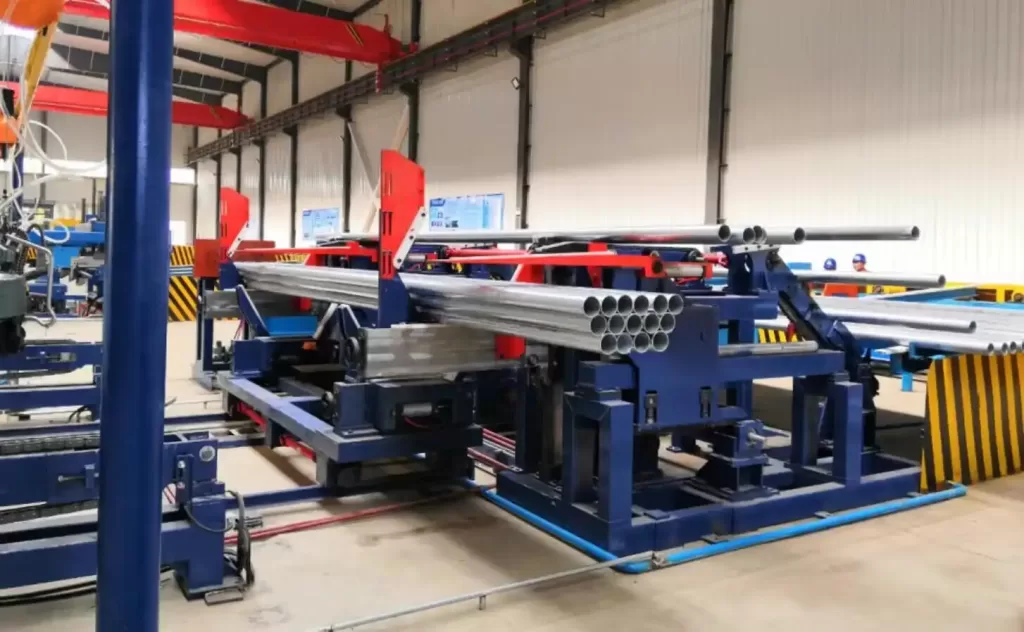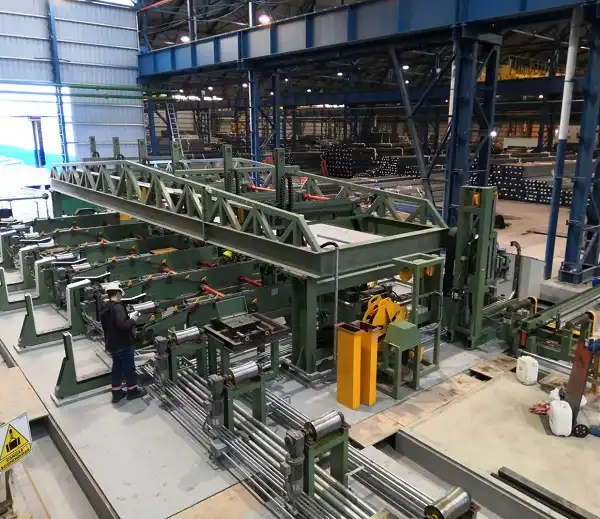Streamlining Steel Tube Protection: An In-Depth Look at Horizontal Stretch Wrappers
Protecting steel tubes during storage and transit is paramount to maintaining their integrity and preventing costly damage. One of the most effective methods for achieving this protection is through the use of horizontal stretch wrapping machines. This article provides a detailed, instructional overview of horizontal stretch wrappers, covering their functionality, benefits, and key considerations for implementation.
Fhopepack horizontal tube orbital wrapping machines are designed primarily for packaging various elongated objects like steel pipes, rods, and copper tubing. These machines represent a fundamental solution for businesses seeking to enhance their packaging efficiency. Here, we'll delve deep into the how and why.
The Role of Horizontal Stretch Wrappers in Tube Protection
A horizontal stretch wrapper applies a protective layer of stretch film around bundles of steel tubes. This film shields the tubes from a multitude of threats, including:
- Physical Damage: Scratches, dents, and abrasions during handling and transportation.
- Corrosion: Exposure to moisture and environmental elements that can lead to rust and degradation.
- Tampering: Unauthorized access or alteration of the product during transit.
By employing horizontal stretch wrapping, manufacturers and suppliers can extend the shelf life of their products, minimize quality issues, and cultivate trust with their clientele.

Key Features of Horizontal Stretch Wrappers
These machines are engineered with precision and durability in mind. Key features typically include:
- Versatile Bundle Handling: Accommodates steel tube bundles of varying diameters (e.g., 20mm to 500mm), lengths (e.g., 1 meter to 12 meters), and weights (e.g., 500kg to 5000kg). Note: Specific capabilities vary by model. Consult manufacturer specifications.
- Constant Tension Mechanism: This is crucial for even film application. A feedback loop system constantly monitors and adjusts the film tension, often utilizing pneumatic or servo-controlled brakes. Typical tension range: 5% to 300% stretch, adjustable via the control panel.
- Automated Cut and Seal System: Ensures a secure and efficient wrapping process. Heat sealing is a common method, with temperature control accuracy within +/- 1°C. Some systems use blades for cutting, followed by hot air or impulse sealing.
- Programmable Logic Controller (PLC): The brain of the operation. PLCs control the unwinder, carriage, and stretch hood mechanisms with precision based on pre-programmed parameters. Programming interfaces usually feature touch-screen displays for easy adjustments.
- Comprehensive Safety Features: Incorporates emergency stop buttons strategically placed around the machine, light curtains to prevent access to moving parts during operation, and overload sensors to protect the machine from damage. Safety circuits comply with international standards such as IEC 61508.
- Robust Construction: Built to withstand the demands of continuous operation in industrial environments. Frames are often constructed from heavy-gauge steel (e.g., Q235 or equivalent) and powder-coated for corrosion resistance. Weld quality is verified through non-destructive testing (NDT).
- Stretch Film Carriage and Unwind System: Allows for precise control over film tension, optimizing film usage based on bundle specifications. Film roll diameter capacity typically ranges from 250mm to 400mm, with core sizes of 76mm (3 inches).
How Horizontal Stretch Wrappers Work: A Technical Breakdown
The horizontal stretch wrapping process is a sophisticated orchestration of mechanical and control systems. Here's a breakdown:
- Bundle Loading: Steel tubes are loaded onto the infeed conveyor of the wrapper. This can be done manually or via automated feeding systems.
- Bundle Positioning: The conveyor precisely positions the bundle within the wrapping zone. Sensors detect the bundle's presence and dimensions, feeding this data to the PLC.
- Film Application: The wrapping carriage, carrying a roll of stretch film, begins to rotate around the bundle. The film unwinds as the carriage spins, applying a spiral wrap.
- Technical Detail: The carriage rotation speed (RPM) controls the wrapping speed. Modern machines can achieve speeds of 10-25 RPM. The overlap percentage (the amount each spiral layer overlaps the previous one) is also adjustable.
- Tension Control: The tension control system maintains consistent film tension throughout the wrapping process. This ensures a tight, secure wrap without damaging the tubes.
- Technical Detail: Tension is controlled using a combination of mechanical brakes on the film roll and a dancer arm system that adjusts the unwinding speed. Servo motors provide precise tension adjustments.
- Cut and Seal: Once the wrapping cycle is complete, the film is automatically cut and sealed. This can be achieved through heat sealing, where a heated element melts the film ends together, or through a blade cut followed by a sealing process.
- Technical Detail: Heat sealing temperatures are typically in the range of 120-180°C, depending on the film type.
- Bundle Unloading: The wrapped bundle is then discharged from the machine, ready for storage or shipment.

steel tube packing line2 Benefits of Using a Horizontal Stretch Wrapper
Investing in a horizontal stretch wrapper offers a range of significant advantages:
- Increased Wrapping Speed: Automates the wrapping process, drastically reducing the time and labor required compared to manual wrapping. Production output can reach 100-150 bundles per hour, depending on bundle size and machine specifications.
- Consistent Wrap Quality: Ensures uniform film tension and overlap, providing superior protection compared to manual wrapping.
- Improved Protection: Provides superior corrosion and damage resistance, extending the shelf life and preserving the quality of the steel tubes.
- Enhanced Workplace Safety: Reduces the need for manual handling of heavy tubes, minimizing the risk of injuries and accidents. Operators work from designated control stations.
- Reduced Material Costs: Optimizes stretch film usage, minimizing waste and saving on material expenses. Pre-stretch film carriages can stretch the film by up to 300%, further reducing material consumption.
- Improved Efficiency: Streamlines the packaging process, increasing overall productivity and volume output.
- Enhanced Brand Image: Demonstrates a commitment to quality and product protection, enhancing customer satisfaction and brand value.
Key Considerations When Choosing a Horizontal Stretch Wrapper
Selecting the right horizontal stretch wrapper requires careful evaluation of your specific needs and requirements. Consider the following factors:
- Bundle Size and Weight: Ensure the machine can accommodate the range of tube bundle sizes and weights you handle. Pay close attention to the machine's maximum diameter and weight capacity.
- Production Volume: Choose a machine with the capacity to meet your production demands. Consider the wrapping speed and the level of automation.
- Film Type and Thickness: Select a machine that is compatible with the type and thickness of stretch film you plan to use. Check the machine's specifications for recommended film gauges.
- Automation Level: Determine the level of automation required for your operation. Options range from semi-automatic machines with manual loading and unloading to fully automatic systems with integrated conveyors and robotic handling.
- Footprint and Space Requirements: Evaluate the available space in your facility and choose a machine that fits comfortably within those constraints.
- Maintenance Requirements: Consider the ease of maintenance and the availability of spare parts. Look for machines with readily accessible components and clear maintenance schedules.
- Supplier Reputation and Support: Choose a reputable supplier with a proven track record and reliable after-sales support. Inquire about warranty terms, maintenance services, and technical assistance.
- Budget: Set a realistic budget and compare the features and capabilities of different machines within that price range. Consider the total cost of ownership, including purchase price, installation costs, maintenance expenses, and film consumption.

steel tube bundle strapping machine Conclusion
Horizontal stretch wrappers are an essential investment for any steel tube manufacturer or supplier seeking to optimize their packaging process, protect their products, and improve their bottom line. By understanding the features, benefits, and key considerations associated with these machines, businesses can make informed decisions and select the right solution for their specific needs. The long-term benefits of enhanced product protection, increased efficiency, and improved customer satisfaction far outweigh the initial investment.

